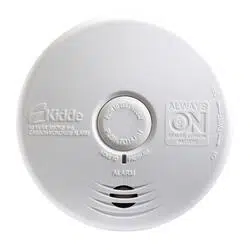Loading ...
Loading ...
Loading ...

This feature is to be used only when a known alarm condition, such as smoke
from cooking, activates the alarm. The smoke alarm is desensitized by pushing
the Test/Hush button on the smoke alarm cover. If the smoke is not too dense,
the alarm will silence immediately and the red LED blinks every 10 seconds. This
indicates that the alarm is in a temporarily desensitized condition.
The smoke alarm will automatically reset within 10 minutes and sound the alarm
if particles of combustion are still present.
The SMART HUSH
TM
feature can be used repeatedly until the air has been
cleared of the condition causing the alarm. Pushing the Test/Hush button on the
alarm will end the temporarily desensitized period.
If the smoke is not too dense, within 10 minutes the alarm will return to normal
operation.
NOTE: Dense smoke will override the SMART HUSH
TM
feature and
sound a continuous alarm.
CAUTION: Before using the alarm SMART HUSH
TM
feature, identify
the source of the smoke and be certain safe conditions exist.
8. BATTERY
NOTE: One lithium battery, permanently sealed inside the alarm, powers this
unit; no battery installation or replacement is necessary for the life of the alarm.
IMPORTANT: Constant exposure to high or low humidity may reduce battery life.
WARNING! DO NOT ATTEMPT TO OPEN THE ALARM
FOR ANY REASON!
Do not try to repair the smoke alarm yourself. No serviceable parts included.
Low battery: This alarm is equipped with a low battery monitor circuit which
will cause the alarm to produce a single “chirp” approximately every 60
seconds and blink the Red LED every 30 seconds, for a minimum of seven
(7) days should the battery become low.
The unit must be replaced within 7 days of the first occurrence of the
“Low Battery Warning” to provide continuous alarm protection. THE
UNIT MUST BE DISCHARGED (see “Permanently Disable Alarm / Discharge
Battery” section) when alarm is in “low battery” condition.
Loading ...
Loading ...
Loading ...
